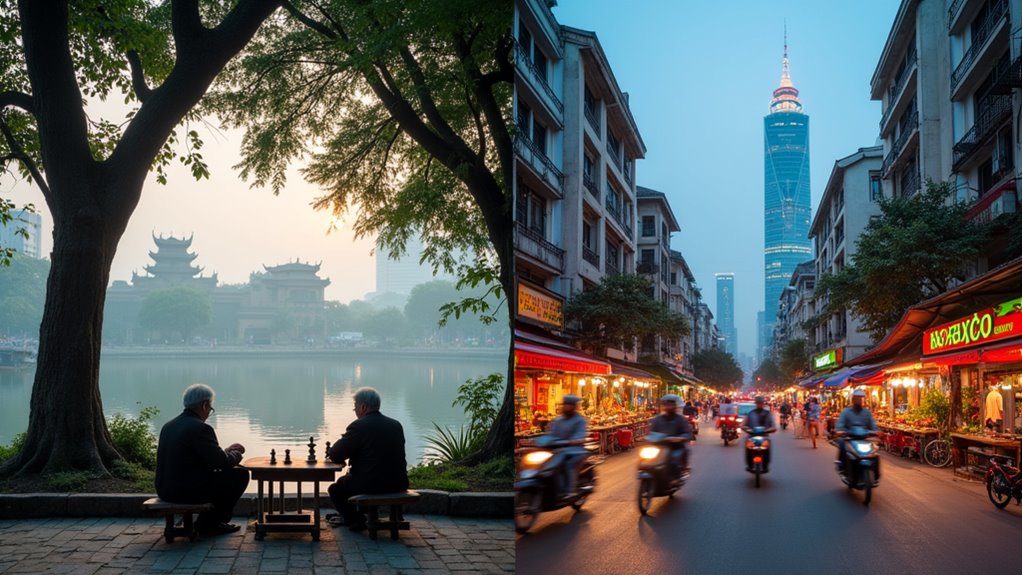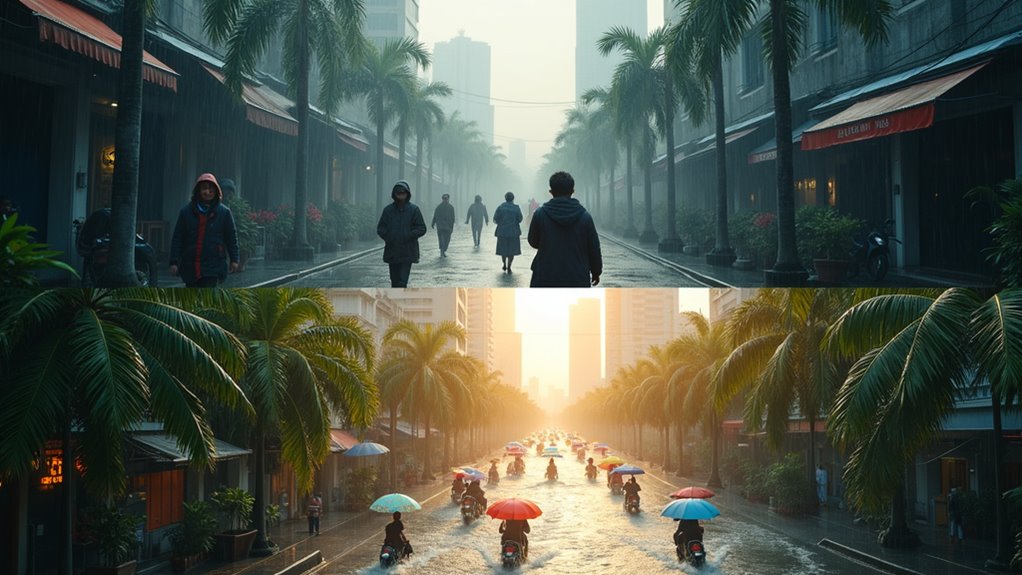Physical Address
304 North Cardinal St.
Dorchester Center, MA 02124
Physical Address
304 North Cardinal St.
Dorchester Center, MA 02124

Unsure whether to visit traditional Hanoi or modern Ho Chi Minh City? Discover which Vietnamese metropolis matches your travel style.
Hanoi offers traditional Vietnamese charm with cooler winters, lower costs, and authentic cultural experiences. You’ll find refined northern cuisine and artisanal shopping in its walkable Old Quarter. Ho Chi Minh City delivers a cosmopolitan atmosphere with warmer year-round temperatures, modern retail, and fusion food influences in a sprawling urban setting. Your preference between authentic tradition (Hanoi) or dynamic modernity (HCMC) will guide your perfect Vietnamese city experience.

When planning a trip to Vietnam, understanding the distinct weather patterns between Hanoi and Ho Chi Minh City can make or break your experience.
Hanoi features hot, wet summers and cool, dry winters, with temperatures ranging dramatically throughout the year. You’ll find January quite chilly at 14.74°C, while June can soar to 32.24°C. Visit Hanoi between September-November or March-May for ideal conditions.
In contrast, Ho Chi Minh City maintains a tropical climate with consistently warmer temperatures year-round (26.47°C-29.10°C). It’s generally 3-4°C warmer than Hanoi, with April reaching highs of 31.74°C. The distinction is due to Ho Chi Minh City’s tropical savanna climate classification. When comparing Southeast Asian destinations, Vietnam offers weather diversity similar to the contrast between Thailand and the Philippines.
For the driest experience, plan your HCMC visit between December and April, avoiding September when rainfall peaks at 193.32mm.
Beyond weather considerations, your wallet will feel different depending on whether you choose Hanoi or Ho Chi Minh City for your Vietnamese adventure. Overall, Hanoi is the more budget-friendly option, with costs running about 5.8% notably lower than its southern counterpart.
Housing creates the biggest price gap—a downtown one-bedroom apartment in Ho Chi Minh City ($476) costs considerably more than in Hanoi ($339).
You’ll also pay more for transportation in Ho Chi Minh City, with monthly transit passes costing $13 compared to Hanoi’s $8.
While grocery costs are marginally higher in Hanoi, dining out and childcare are cheaper there. Enjoying a domestic beer is significantly more affordable in Hanoi, costing about 33.3% less than in Ho Chi Minh City.
Street food remains affordable in both cities, though tourist areas in Ho Chi Minh City can strain your budget more quickly. This cost difference pattern mirrors what travelers experience when choosing between Asian capitals like Tokyo and Seoul, though Vietnam remains more affordable overall.

The cultural contrast between Hanoi and Ho Chi Minh City represents Vietnam’s fascinating duality of tradition and modernity. In Hanoi, you’ll experience a more authentic Vietnamese atmosphere shaped by Chinese influences and over 1,000 years as the capital. The city’s village gates and traditional architecture reflect its deep historical roots. Visitors to Hanoi often notice its French colonial architecture that blends seamlessly with traditional Vietnamese design elements.
Ho Chi Minh City offers a cosmopolitan vibe, blending Khmer, Indian, Malay, and Western influences from its history as a trading hub. You’ll find Hindu temples alongside French colonial buildings in this cultural melting pot. While Vietnam is generally safe, some areas near Ho Chi Minh City may appear on danger advisories for international travelers.
Socially, Hanoians tend to be more reserved and traditional, while Saigonese are typically more direct and open-minded. Both cities boast vibrant nightlife, but Hanoi leans toward traditional arts while Ho Chi Minh City embraces international pop culture.
Vietnam’s cultural divide extends beautifully to its kitchens, where regional differences create two distinct culinary worlds.
In Hanoi, you’ll discover the refined elegance of Northern classics like Bún Thang with its precise balance of ham, chicken, and egg strips in clear broth. The city’s famed Chả Cá features secretly marinated catfish grilled and stir-fried tableside with aromatic dill and spring onions. Traditional Bún Chả and delicate Bánh Cuốn showcase Hanoi’s commitment to time-honored recipes with Chinese influences. When dining in Hanoi, remember to follow proper etiquette such as using chopsticks correctly and not leaving them standing upright in your rice bowl.
Ho Chi Minh City offers a more experimental approach. Southern fusion shines through crispy Bánh Khot, vibrant Gỏi Cuốn, and the satisfying crunch of Bánh Xèo. The South’s cuisine incorporates more Southeast Asian flavors from Indian and Malay influences, with abundant seafood and a willingness to adapt.
While Hanoi holds tight to culinary tradition, both cities now embrace innovation, with food festivals and cross-regional experimentation creating exciting new dining landscapes.

Traversing the urban landscapes of Hanoi and Ho Chi Minh City reveals stark contrasts in transport infrastructure and city planning philosophies. Hanoi’s compact Old Quarter favors pedestrians and cyclists, while HCMC’s sprawling layout necessitates motorized transport.
Both cities offer affordable buses (7,000-15,000 VND), but HCMC relies heavily on motorbike taxis due to its size. Cyclos provide traditional, slow-paced sightseeing opportunities in both cities, especially for travelers wanting to experience local culture. Hanoi’s urban rail line provides limited relief while HCMC’s metro remains under construction.
The cities’ distinctive layouts—Hanoi’s narrow, labyrinthine streets versus HCMC’s wider boulevards—directly impact your navigation experience.
For intercity travel, you’ll find numerous options: the quick Hanoi-HCMC flight (2 hours), scenic Reunification Express train (36 hours), or economical sleeper buses (34 hours). When comparing Vietnam to other Southeast Asian destinations, many travelers find the transport options more diverse and economical than in places like the Philippines.
Urban congestion peaks during 7-9 AM and 5-7 PM in both cities.
When your feet tire from exploring Hanoi and Ho Chi Minh City’s bustling streets, retail therapy offers a welcome change of pace while deepening your culture.
Hanoi’s Old Quarter, with its 36 streets of specialized trades, delivers authentic shopping through traditional markets like Dong Xuan and Van Phuc for silk textiles. You’ll find fewer malls but more handcrafted treasures like lacquerware and pottery. Compared to Ho Chi Minh City, Hanoi generally offers better quality products across categories including bags, clothes, and electronics. While exploring local markets, travelers should be aware that Vietnam is home to venomous snakes that inhabit rural areas surrounding both cities.
Ho Chi Minh City caters to modern shoppers with numerous upscale malls like Diamond Plaza and Times City, while Ben Thanh Market provides souvenir hunting. Prices are generally negotiable here, with haggling more common than in Hanoi.
Both cities offer vibrant night markets where you can practice your bargaining skills, though each shopping scene reflects its city’s distinct character – Hanoi’s traditional craftsmanship versus Ho Chi Minh’s contemporary retail landscape.
Whether you’re drawn to Hanoi’s ancient soul or Ho Chi Minh City’s electric pulse, Vietnam offers you a tale of two cities as different as yin and yang. You’ll stretch your dong further in Hanoi, but HCMC delivers modern comforts at a premium. The choice isn’t just about weather or food—it’s about which Vietnamese rhythm resonates with your travel heartbeat. Both cities await, each with its own irresistible melody.